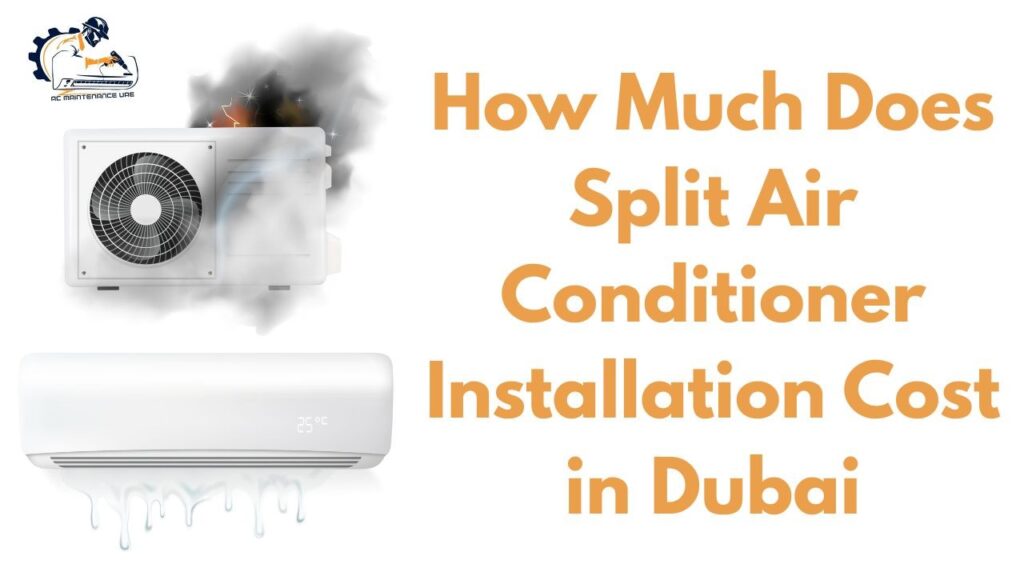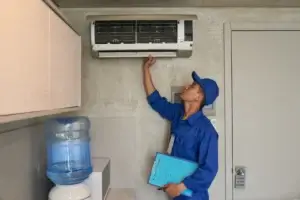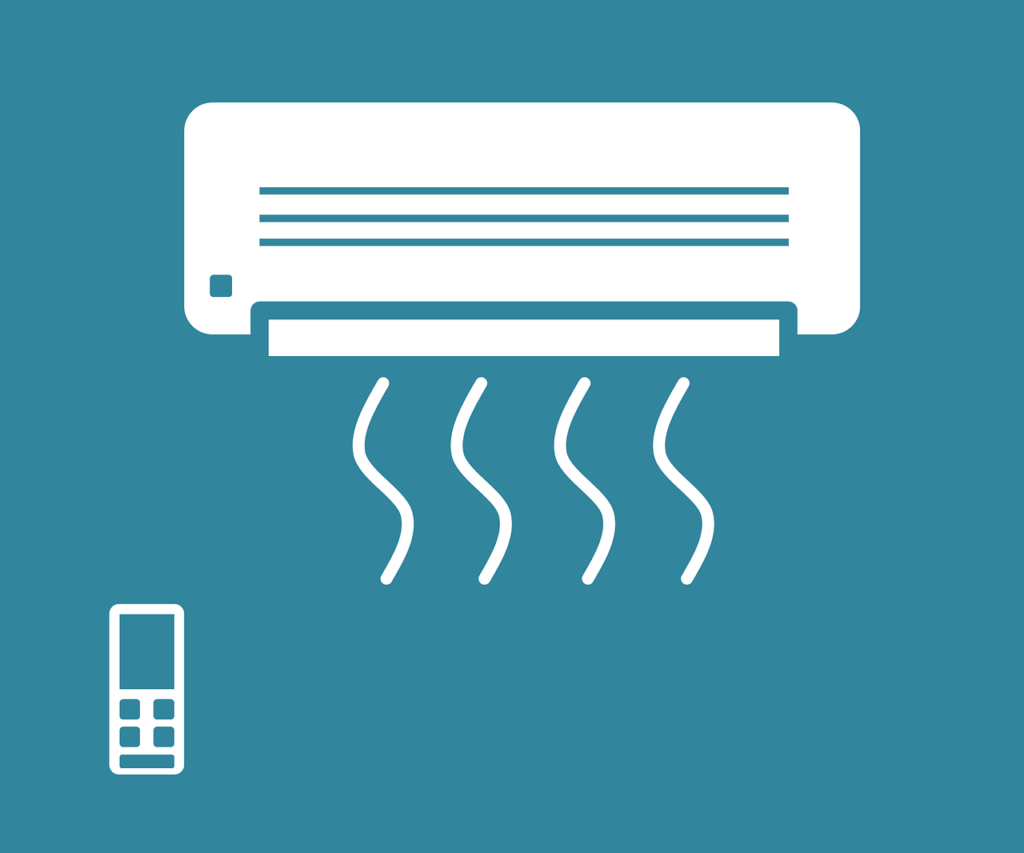Thinking about installing a split AC in your Dubai home but worried about hidden costs? You’re not alone; many homeowners struggle to budget for split air conditioner installation without understanding what drives the price. This comprehensive guide breaks down every cost factor, installation step, and money-saving tip, so you can make an informed decision and stay cool without breaking the bank.
What is Split Air Conditioner Installation?
The term split air conditioner installation refers to a two-part air conditioning system installed indoors and outdoors (indoors is the unit that blows cool air, and the outside is the compressor). Unlike window ACs, everything is connected between the indoor and outdoor units via refrigerant lines and electrical wiring, which is why a licensed HVAC technician is recommended for installation. Total installation times can range between 4-6 hours and will depend on the layout of your home and the size of the AC unit.
Identifying the Components of a Split AC system

For all intents and purposes, a split AC system consists of two main components that work together as one system.
The indoor unit consists of:
- Evaporator coil – The evaporator coil absorbs heat from your bedroom
- Blower fan – The blower fan moves the cooled air through your home
- Air filters – The air filters trap any dust and allergens in the air
- Thermostat and control panel– used to monitor the temperature in your home or bedroom
The outdoor unit consists of:
- Compressor – The compressor pressurizes the refrigerant
- Condenser coil – The condenser coil exhausts the heat to the outside air
- Expansion valve – The expansion valve is responsible for maintaining the proper flow of refrigerant
- Fan – The fan exhausts the heat from the condenser coil efficiently
Additionally, the refrigerant line set, electrical cables, and condensate drainage pipe run between the two split AC units. The refrigerant absorbs the heat in your indoor living spaces and returns the cooled refrigerant to the indoor unit. Having the two units installed separately allows for less noise while operating, as your compressor is located outside of the living space.
How Split ACs Differ from Window Units
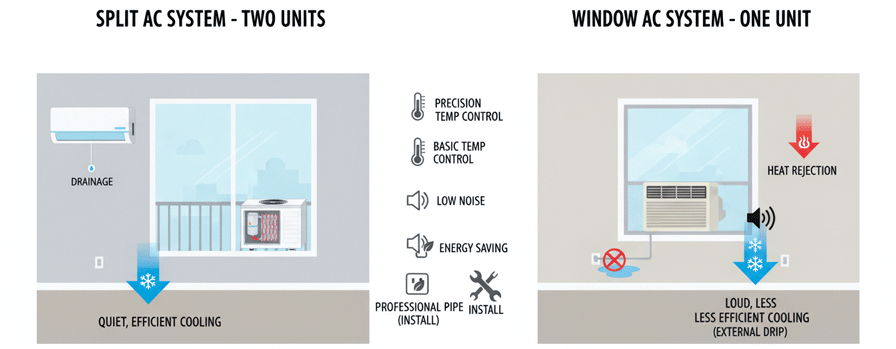
Window units are compact cooling systems located in the window frame, while split systems offer more choices about where you place and install them. Air conditioning split systems generate better cooling efficiency than window AC units, plus they operate significantly quieter. And, perhaps most importantly, they don’t obstruct your natural light and window space.
There is also a considerable difference in installation complexity between the two options. A window AC is an easy DIY install on your own; a split system requires a company to properly drill into walls, run refrigerant from the outdoor unit to the indoor unit, and wire the proper electrical lines. This is why it is important to use professional wall mounted ac unit installation services to make sure it operates properly.
Step-by-Step Guide: How to Install a Split AC Unit
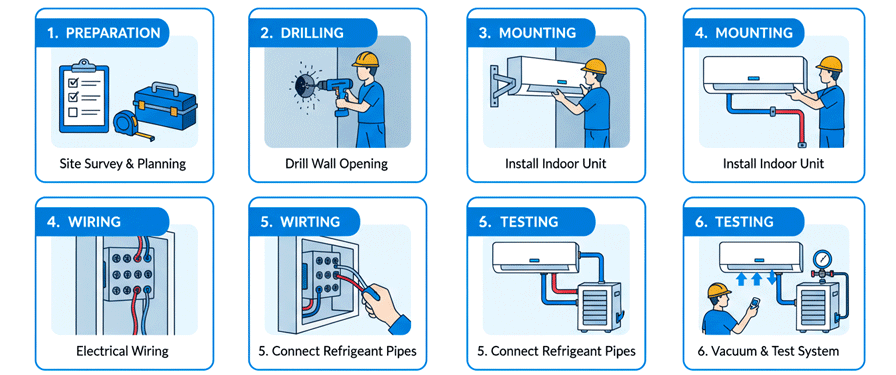
Installing a split AC requires precision and technical knowledge to ensure efficient operation. Understanding how to install a split ac unit helps you oversee the process and communicate effectively with installers. While hiring certified technicians from AC Maintenance UAE ensures warranty compliance and safety standards are met, knowing the steps helps you appreciate the complexity involved.
Installation Process Overview:
- Preparation Phase – Mark drilling locations and prepare the wall
- Indoor Unit Setup – Mount the bracket and secure the unit
- Outdoor Unit Placement – Install the compressor on a stable platform
- Line Connection – Run refrigerant lines through the wall
- Electrical Wiring – Connect power supply with proper circuit protection
- System Testing – Vacuum lines, charge refrigerant, and test operation
Required Tools and Materials
A professional installation will arrive with specialized tools that will ensure the installation is conducted properly. The full kit includes:
Installation Tools:
- Drilling machine with masonry bits to penetrate walls
- Vacuum pump to evacuate moisture from the refrigerant lines
- Refrigerant gauges to properly charge the system
- Tube cutters and flaring tools for line preparation
- Spirit level for proper alignment
- Torque wrenches to make secure connections
Materials:
- Mounting brackets and anchors
- Copper tubing and insulation
- Electrical wire and circuit breakers
- Drain pipes and fittings
- Refrigerant gas (R410A or R32)
- Decorative line covers for a nice finish
If quality materials were not used to install your system you may have efficiency issues for years to come. Many installation packages such as AC Maintenance UAE will already include all of these materials in the quote.
Safety Precautions Prior to Installation
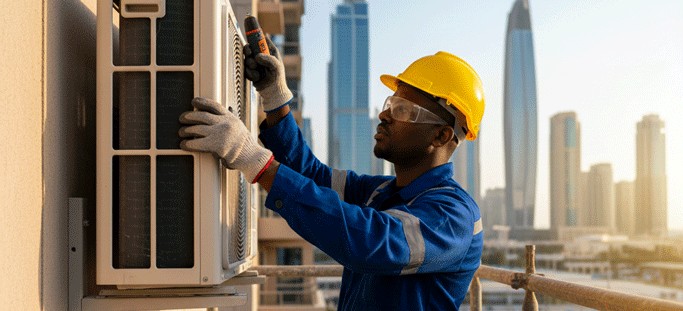
As always, the safe and recommended practice for any electrical work is to ensure you have turned off the electricity at the main breaker, even when you are performing electrical work on the system itself. The indoor and outdoor units (especially the higher-rise models) could be especially heavy, so be sure to check that the wall structure can support the weight as it applies to the chosen application, and check for any local building codes that may restrict the location or specifics on outdoor units. Also double-check for any noise codes.
Critical Safety Measures:
- Wear protective gloves and safety goggles
- Use harnesses for outdoor unit installation at heights
- Verify wall integrity before drilling large holes
- Check for hidden electrical wiring and plumbing
- Ensure proper ventilation when working with refrigerants
- Have fire extinguisher nearby during electrical work
Professional installers carry liability insurance covering any installation-related damages to your property.
Common Mistakes to Avoid During Installation
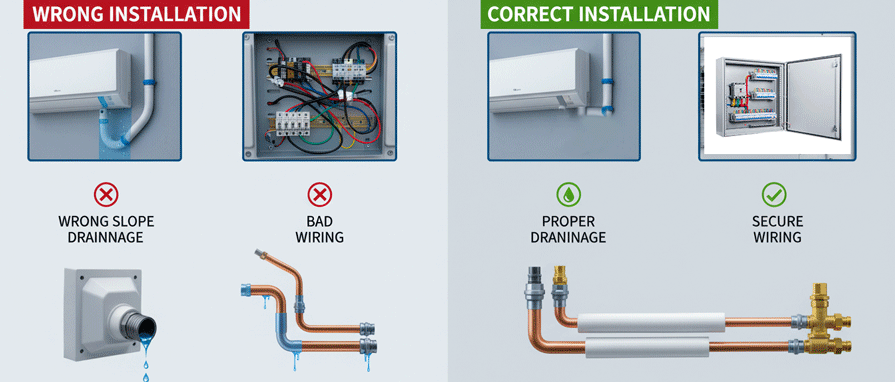
Failing at DIY often has to do with the sizing of the refrigerant lines and cooling efficiency. Also, if the indoor unit is installed too close to the ceiling, you will be restricting airflow, and there will be hot spots. If you don’t have the proper slope on your drainage, you will develop water leaks and cause wall damage in the future.
Below is the list of the top installation errors:
- Not vacuuming the lines causes moisture to remain in the lines.
- Incorrectly connecting your electrical lines will short out the control boards.
- Not insulating the lines correctly will cause you to lose energy.
- Using an undersized drainage pipe will cause water backup.
- Incorrectly charging the refrigerant will cause inefficiency.
- Loose connections will cause leaks.
You can save yourself way more time and money than it would cost to have a professional do it in the beginning.
Wall Mounted AC Unit Installation Explained
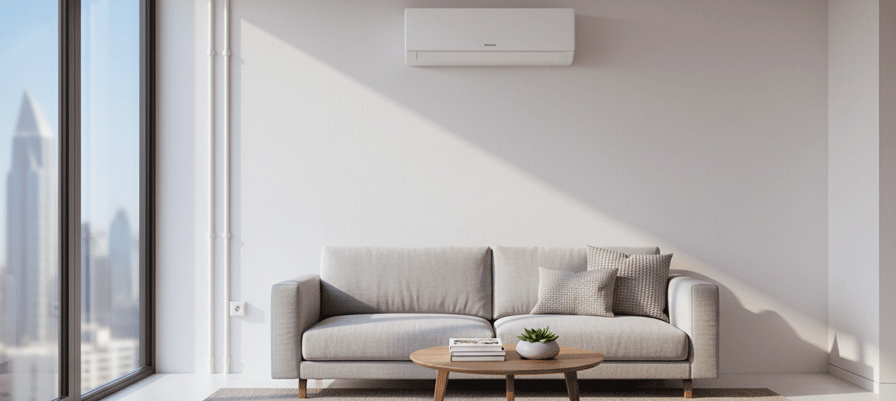
Installing a wall mounted ac unit begins with finding the perfect location for maximum cooling coverage. The indoor unit should be mounted 7-8 feet high on a wall that is sturdy and away from direct sunlight. Installers will mark the drill point, ensure the mounting plate is level, and hang the unit on the brackets with care.
Proper installation tilts the product slightly back for drainage and provides enough clearance to assure airflow. The completed installation conceals the refrigerant lines within decorative covers so that the appearance of the room is maintained. Experts will install your wall-mounted ac unit so that it operates efficiently while providing a beautiful aesthetic.
Selecting the right wall
Choose an interior wall that will allow for the shortest refrigerant line run to the outdoor unit to reduce installation costs. It is best to avoid walls that have electrical wiring, plumbing or structural beams as drilling can be complex and costly.
Ideal location criteria:
- At least a six inch clearance on all sides for airflow
- Out of direct sunlight and heat sources
- Avoid electronic devices in close proximity that could interfere with the thermostat
- Support central position in order to promote air distribution
- Make sure the unit is easily accessible for filter cleaning and maintenance
Provide a clear line of sight to room occupants
Also, if possible, consider furniture placement in the room to avoid obstructing airflow across the entire room. A good wall choice will maximize the ac’s cooling efficiency and lower energy consumption.
Mounting and Securing the Indoor Unit
Begin by drilling holes through the wall for refrigerant lines and drainage pipes at a slight downward angle. Secure the mounting plate to wall studs using heavy-duty anchors and bolts. Use a spirit level to ensure perfect horizontal alignment, as even slight tilts affect drainage performance.
Mounting Process Steps:
- Mark drill points using the mounting template
- Drill pilot holes and insert wall anchors
- Secure mounting plate with stainless steel bolts
- Verify level alignment in multiple directions
- Create refrigerant line passage through wall
- Connect all lines before hanging the unit
- Slide unit onto mounting hooks securely
Double-check all connections and test the unit’s stability before proceeding with the outdoor unit installation phase.
Tips for Efficient Cooling and Airflow
Direct airflow away from beds, workstations, and areas where people sit for extended periods to prevent discomfort. Keep the air filter clean by washing it monthly to maintain optimal airflow and cooling capacity.
Airflow Optimization Tips:
- Position ceiling fans to circulate cool air effectively
- Maintain 5 feet of clear space in front of unit
- Close curtains during peak sunlight hours
- Set temperature to 24°C for optimal efficiency
- Use timer functions to reduce energy waste
- Schedule regular maintenance with AC Maintenance UAE
Regular professional maintenance ensures your system operates at peak efficiency year-round.
Outdoor Unit Installation Best Practices
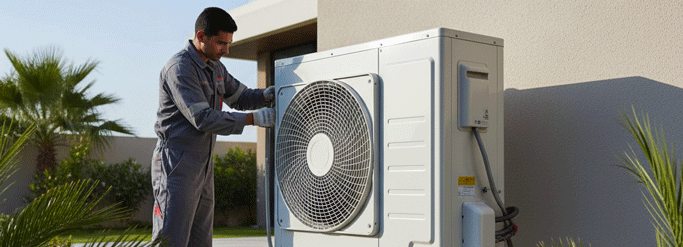
The installation of the outdoor unit is a multi-faceted process that demands thoughtful considerations whether originating from an original design or not. There must be a stable platform for the compressor to sit on where it will drain correctly while allowing an appropriate air flow with adequate clearance. The installation’s fasteners will be mounted to restrain vibrations leading to annoying noise conditions. This is important because refrigerant lines will be connected so as to not allow leaks to develop during the expected service life.
When it comes to connecting the electric service to the outdoor unit you will want to also have that done appropriately and use dedicated circuit breakers (that also protects the unit if there is a power surge). The outdoor unit must be planned with its placement so it can work effectively not only for the indoor unit but even considering the possible effects of the breeze from the unit on your neighbor’s enjoyment of the outdoors. Following the tried and true best practices, you will save unnecessary repairs and get the most useful life out of your investment.
Selecting the Place for the Outdoor Unit
The area should be considerably shaded, and can also be a simply explained installation technique to ensure the brighter light does not impact the indoor environment by using some other means of devices and/or installation components. Allow adequate clearance from 12 inches from all other objects around the compressor so that it can operate effectively and then be effective in exhausting heat and circulation.
Guidelines for the installation of the outdoor unit:
- At ground level or on a reinforcement balcony
- Distance from a bedroom window to avoid noise
- Not exposed or under an awning to face heavy rain
- Easy access when it is due for maintenance and/or repairs
- Preferably secured in the mounting to deter theft
- A successful amount distance to all other properties if applicable.
The location must have specified distance for a short as possible line run from the unit to optimally reduce the split ac installation cost and overall service.
Proper Mounting, Drainage, and Electrical Setup
Mount the outdoor unit on a concrete pad or anti-vibration rubber feet to reduce noise transmission. Install with a slight tilt for condensate drainage away from the unit. Use weather-resistant mounting brackets for wall installations on upper floors.
Electrical Connection Requirements:
- Dedicated circuit breaker sized for unit capacity
- Weatherproof electrical box and conduit
- Proper grounding to prevent electrical hazards
- Surge protector for component protection
- Correct wire gauge based on distance and amperage
- Professional electrician certification for compliance
Ensure all electrical work meets Dubai Municipality regulations and manufacturer specifications.
Ensuring Optimal Airflow and Noise Reduction
Position the unit where discharged air won’t blow directly toward windows or outdoor seating areas. Install anti-vibration pads beneath the compressor to minimize operational noise. Maintain proper clearances as specified by the manufacturer for efficient heat exchange.
Noise Reduction Strategies:
- Use rubber mounting pads to absorb vibrations
- Install acoustic barriers if required
- Ensure fan blades are balanced and clean
- Secure all panels and covers properly
- Keep unit away from reflective surfaces
- Schedule regular professional servicing
Proper installation and maintenance keep your outdoor unit running quietly and efficiently throughout Dubai’s hot summers.
Split AC Installation Cost Breakdown
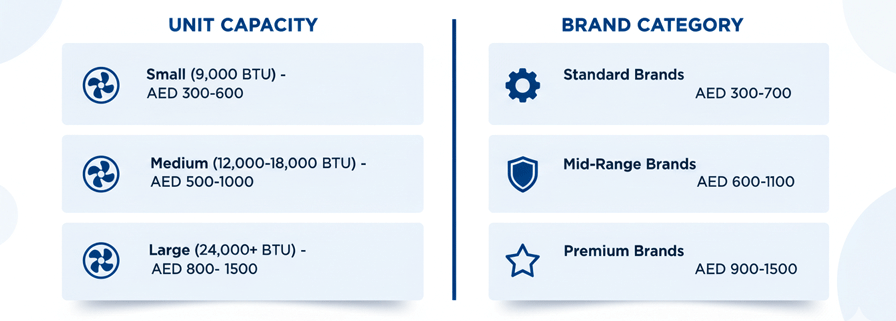
The Split ac installation cost in Dubai is highly variable and can be affected by several factors such as the capacity of the unit being installed, the brand of the unit, complexity of installation etc. A standard installation for a 1.5 ton unit can range between AED 300-600, while units being installed between 2-3 tons can range from AED 600-1200. The installation cost includes labor, basic material, and standard installation costs which exclude any optional or additional costs related to any complications or modifications.
Premium brands can make the installation costs higher, and also depending on how complex the installation is and if more piping or electrical is required, costs can go up to AED 1,500-2,500. Recognizing your own individual cost breakdowns and estimation structure will help to ensure that you are budgeting your installation correctly and limit any concerns of unexpected costs. AC maintenance UAE gives transparent pricing practices on every project, while all proposals clearly break down the cost for each installation component.
Factors That Affect Installation Cost
Installation location significantly impacts pricing, with high-rise apartments requiring specialized equipment and safety measures. Wall material affects drilling difficulty; concrete walls cost more than gypsum or brick installations. Distance between indoor and outdoor units increases refrigerant line length and material costs.
Key Cost Factors:
- Unit Capacity – Larger tonnage requires more labor and materials
- Brand Selection – Premium brands have specific installation requirements
- Wall Type – Concrete drilling costs more than standard walls
- Height – Upper floor installations require safety equipment
- Line Length – Extra piping beyond standard 3 meters adds cost
- Electrical Work – New circuit installation increases total price
- Accessibility – Difficult outdoor locations require additional labor
Average Cost Range by Brand and Capacity
Different brands command varying installation costs based on their technical requirements and warranty specifications. Standard mini split ac installation cost differs from traditional split systems due to simpler installation processes.
Dubai Installation Cost Ranges (2025):
By Capacity:
- 1 Ton Unit: AED 300-500
- 1.5 Ton Unit: AED 400-700
- 2 Ton Unit: AED 600-1,000
- 2.5 Ton Unit: AED 800-1,200
- 3 Ton Unit: AED 1,000-1,500
By Brand Category:
- Budget Brands (General, Gree): AED 300-600
- Mid-Range (LG, Samsung): AED 500-900
- Premium (Daikin, Mitsubishi): AED 700-1,200
- Luxury (Fujitsu, Panasonic): AED 900-1,500
These prices include standard installation; custom requirements add additional costs.
Tips to Save on Installation Expenses
Consider purchasing air conditioning (AC) units during the offseason months (November-February) when demand is fewer and suppliers will often provide reductions in price. Obtain multiple quotes from certified installers to ensure you get the best pricing. When dealing with multiple installations in one home, consider bundling rooms so that you have a better unit rate per room.
Money-Saving Tips:
- Buy during promotional seasonal sales for package deals
- Select locations that have arranged long lines
- Clear your installation site of designated area beforehand
- Choose units that have installation done included (for added costs)
- Avoid costly, unnecessary custom modifications
- Be mindful of clearance to reduce future costly needs.
- Contact AC Maintenance UAE to get installed at competitive prices, assurance of quality workmanship.
The investment in professional installation at the outset will save you from costly repairs and ensure efficiency for many years.
Split AC vs Central AC Installation Cost Comparison
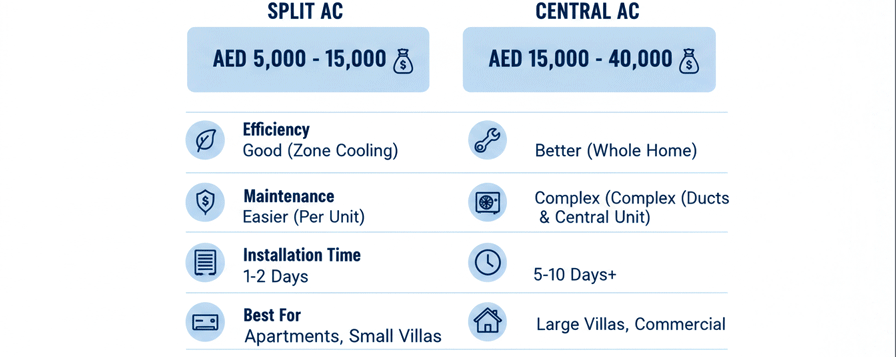
When looking at split ac vs central ac installation cost there are some major differences in initial outlay and value over time. A central AC would involve hefty ductwork, which on average costs between AED 15,000 – 40,000 to hook up in a typical Dubai villa. For the same space, you may spend as low as AED 5,000 – 15,000 for several splits. Central AC allows for whole house comfort utilizing concealed ducting, but there are higher annual service costs and energy to consume. Splits allow you to control temperature by room, cutting down on wasted energy in rooms that are not being used. The choice you will make will come down to the size of your property, the level of comfort you require, and of course your budget.
Installation Complexity and Equipment Differences
The installation of central air conditioning necessitates months of designing your ducts and then physically installing the ducting throughout your home. Central AC installation requires taking multiple days and heavy modifications to your structure. Central AC installation requires you to put in a very large outside condenser and indoor air handler, all of the thermostats wired, and sealing your ductwork in multiple places. There is plenty of complexity that will require more than just your basic HVAC contractors, as this process can be time consuming and detailed.
Central AC Installation Requirements:
- Complete duct system design and fabrication
- Ceiling space modifications for duct routing
- Large outdoor condenser pad installation
- Air handler unit placement in utility room
- Complex electrical panel upgrades
- Zoning system for temperature control (optional)
Split AC Installation Requirements:
- Individual unit mounting per room
- Simple refrigerant line runs through walls
- Compact outdoor unit placement
- Basic electrical connections per unit
- No structural modifications required
- Flexible installation timeline
Split AC installation can be completed room-by-room as budget allows, while central systems require complete installation before operation.
Energy Efficiency and Long-Term Savings
Modern split ACs achieve SEER ratings of 16-22, while central systems typically range from 14-18 SEER. Split systems excel in energy efficiency because you only cool occupied rooms, potentially reducing energy bills by 30-40% compared to central AC. Each split unit operates independently, preventing energy waste when cooling unused spaces.
Energy Cost Comparison (3-Bedroom Villa):
- Central AC – AED 800-1,200 monthly during summer
- Split AC System – AED 500-800 monthly with selective cooling
- Annual Savings – AED 3,600-4,800 with split systems
Maintenance costs also differ significantly. Central AC requires annual duct cleaning (AED 500-800) plus filter replacement and system servicing. Split ACs need only filter cleaning and periodic refrigerant checks, typically costing AED 150-300 per unit annually with AC Maintenance UAE.
Which Option is Best for Your Home?
If you have a larger villa (more than 3,000 sq ft), prefer a concealed system, and cool your entire home day-in and day-out, choose central AC. Central AC systems add value to your home and provide a consistent level of comfort throughout. Central AC is especially good for homes with open floor plans where multiple split systems would affect the aesthetics.
Choose Split AC Systems If:
- You are in a townhouse or apartment.
- You like to control the temperature in each room, as needed.
- You want lower costs when you initially buy an AC system.
- You want flexibility in your schedule for installing AC.
- You cool specific rooms differently, at different times.
- You want easier access for maintenance.
- You want a modern look, visible, design-style aspects.
Choose Central AC If:
- You have a large villa and want to cool the whole house.
- You want the concealed ductwork aesthetics.
- You like running the AC all the time, in every room.
- You are building new construction and want ducts built into the plan.
- You want control of the temperature all in one place.
- You want to create more resale value for your property.
Most apartments and smaller villas in Dubai will benefit more from split AC systems because of the cost benefit and flexibility with split AC systems. AC Maintenance UAE will have options to help determine your needs and recommend the best cooling system for you.
Mini Split AC Installation Cost Guide
Mini split air conditioner installation cost in Dubai generally falls between AED 2,500-6,000 for a complete multi-zone system, which connects one outdoor unit to multiple indoor units (typically connecting 2-5 zones). In comparison to standard split ac systems, mini splits offer better flexibility since they are ductless. Single zone installations cost AED 1,800-3,500 including installation which are also competitively priced against typical split systems.
Mini splits can include more advanced features such as inverter technology, Wi-Fi capability and zone-controlled cooling. They are excellent for a new room addition, including converted garages, basements, or homes without ductwork. Knowing your investment will help you decide if mini splits work for your cooling needs or budget.
What Makes Mini Splits Different from Standard Split ACs
Mini split systems are designed with an inverter technology that turns the compressor speed up or down continuously to maintain a constant temperature. Unlike a standard split AC that turns on and off to maintain a temperature, mini splits continuously run at variable speeds which allow for a 25-40% reduction in energy consumption. Inverter technology not only eliminates temperature fluctuations, they also reduce the workload of on and off cycling which reduces the wear and tear on the mechanical components.
Key Mini Split Advantages:
- Multi-Zone Capability – One outdoor unit serves multiple rooms
- Inverter Technology – Variable speed operation for efficiency
- Whisper-Quiet Operation – Noise levels as low as 19 decibels
- Advanced Filtration – Superior air purification systems
- Smart Controls – Wi-Fi and app-based temperature management
- Compact Design – Sleeker indoor units than traditional splits
- Longer Lifespan – Reduced compressor wear extends unit life
Standard split ACs use fixed-speed compressors and typically serve one indoor unit per outdoor compressor, limiting flexibility for multiple room cooling.
Typical Cost Range for Mini Split Systems
Mini split pricing varies based on the number of zones, total capacity, and brand selection. Multi-zone systems require more complex installation but cost less per room than installing individual split ACs.
Mini Split System Costs in Dubai:
Single-Zone Systems:
- 1 Ton Capacity: AED 1,800-2,500
- 1.5 Ton Capacity: AED 2,200-3,000
- 2 Ton Capacity: AED 2,800-3,800
Multi-Zone Systems:
- 2-Zone System (2.5 tons total): AED 4,500-6,500
- 3-Zone System (3.5 tons total): AED 6,500-9,000
- 4-Zone System (4.5 tons total): AED 8,500-12,000
Installation costs are included in these ranges. Premium brands like Mitsubishi and Daikin command higher prices but offer superior efficiency and reliability. Budget brands reduce initial costs but may lack advanced features.
Is a Mini Split Worth the Investment?
Mini-split air conditioning systems can save you 30-40% in energy or approximately $300-$600 annually, which could allow you to recover the initial higher cost of equipment and installation within only 3-4 years when your electricity bills drop. In addition, inverter technology mini-splits will last 15-20 years (versus standard AC units which only last 10-12 years) and therefore you can justify the higher cost of your initial investment. The extra value of precise temperature and quieter operation will also contribute to your comfort and well-being.
Return on Investment Factors:
- Monthly Savings – AED 150-300 per unit on electricity
- Maintenance Costs – Lower than multiple standard ACs
- Property Value – Modern systems increase resale appeal
- Comfort Level – Superior temperature consistency
- Durability – Longer operational lifespan
- Warranty Coverage – Extended warranties often included
For homes requiring 2-4 room cooling, mini splits often cost less than installing individual split ACs while providing better efficiency. Consult AC Maintenance UAE to evaluate whether mini split technology suits your specific cooling requirements and budget constraints.
Frequently Asked Questions
Q.1 How much does split air conditioner installation typically cost in Dubai?
Standard split air conditioner installation in Dubai costs AED 300-1,200 depending on unit capacity, brand, and installation complexity. A 1.5-ton unit typically costs AED 400-700, while 2.5-3 ton systems range from AED 800-1,500 including labor and basic materials.
Q2. Can I install a split AC unit myself or do I need a professional?
While understanding how to install a split ac unit is helpful, professional installation is strongly recommended. Licensed technicians ensure proper refrigerant handling, electrical connections, and warranty compliance. DIY installation risks system damage, safety hazards, and voided warranties that cost more to fix than professional installation.
Q3. How long does wall mounted AC unit installation take?
Wall mounted ac unit installation typically takes 4-6 hours for a single unit by experienced technicians. Complex installations requiring electrical upgrades or extensive refrigerant line runs may take 6-8 hours. Multiple unit installations can be completed in one day depending on accessibility and site preparation.
Q4. What’s included in the outdoor unit installation cost?
Outdoor unit installation costs typically include mounting brackets, anti-vibration pads, electrical connections, and basic refrigerant line runs up to 3 meters. Extended line lengths, custom platforms, protective cages, and electrical panel upgrades incur additional charges. Always request detailed quotes specifying included components.
Q5. Is mini split AC installation cost higher than regular split AC?
Mini split ac installation cost is 20-30% higher per unit initially, ranging from AED 1,800-3,500 for single zones. However, multi-zone mini split systems cost less than installing multiple traditional split ACs for the same coverage, making them cost-effective for multi-room cooling needs.
Q6. How does split AC vs central AC installation cost compare for villas?
Split ac vs central ac installation cost shows split systems cost AED 5,000-15,000 for typical villas versus AED 15,000-40,000 for central AC with ductwork. Split systems offer lower upfront investment, flexible installation scheduling, and room-by-room control. Central AC provides concealed aesthetics and whole-home comfort but requires higher maintenance.
Q7. Does AC Maintenance UAE offer installation warranty and support?
Yes, AC Maintenance UAE provides comprehensive installation warranties covering workmanship and materials for 1-2 years. We offer post-installation support, annual maintenance contracts, and emergency repair services. Our certified technicians ensure installations meet manufacturer specifications and Dubai Municipality regulations for optimal performance and longevity.
Conclusion
Knowing the costs and procedures of split air conditioner installation will help you make the best cooling decisions for your home in Dubai. Your decision-making process will be influenced by choosing between standard splits, mini splits, and central AC, along with placement of wall mounted ac unit installation and outdoor unit installation. All self-explanatory decisions will range from cost to your comfort level.
Cost of installation averages from AED 300-1,500 depending on brand, capacity, and complexity. However, mini split ACs usually provide better efficiency, but are slightly more costly.
Now that you’ve developed an understanding of how to budget for split AC installation and what to expect during the procedure, are you ready to enjoy perfectly cool comfort in your home? Please contact AC Maintenance UAE to provide you with installation services in a professional manner, transparent pricing, in-house technicians, and industry standard warranty on installation.
AC Maintenance UAE Team
Welcome to AC Maintenance UAE, your reliable partner for complete air conditioning repair and maintenance services in Dubai, Sharjah, and Abu Dhabi. We are strongly dedicated to excellence and deliver efficient and reliable services to keep your cooling systems performing at their best.
- AC Maintenance UAE Teamhttps://acmaintenanceuae.com/author/ac_mainten_admin/
- AC Maintenance UAE Teamhttps://acmaintenanceuae.com/author/ac_mainten_admin/
- AC Maintenance UAE Teamhttps://acmaintenanceuae.com/author/ac_mainten_admin/
- AC Maintenance UAE Teamhttps://acmaintenanceuae.com/author/ac_mainten_admin/

